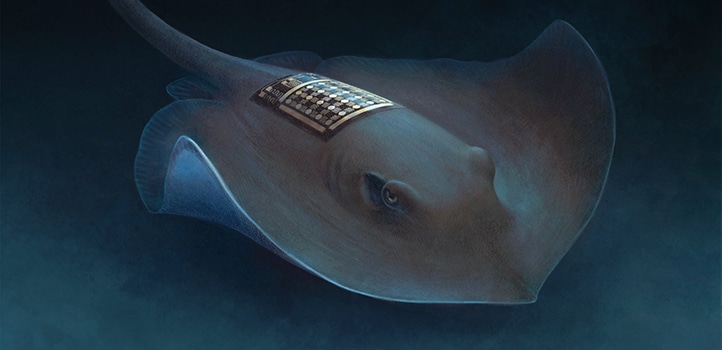Apr 23 2019
A new and significantly enhanced version of an electronic tag, referred to as Marine Skin, used for tracking marine animals could transform man’s ability to scrutinize sea life and its natural habitat, say KAUST scientists.
 The new version of Marine Skin showed improved performance, flexibility and durability when attached to different fish, including stingrays. (© 2019 KAUST; Xavier Pita)
The new version of Marine Skin showed improved performance, flexibility and durability when attached to different fish, including stingrays. (© 2019 KAUST; Xavier Pita)
Marine Skin is a thin, flexible, lightweight polymer-based material with incorporated electronics which can monitor an animal’s movement and diving behavior and the health of the neighboring marine environment. Early models of the sensors, reported earlier, proved their value when glued onto the swimming crab, Portunus pelagicus.
The newest and much more powerful version can work at unparalleled depths and can also be attached to an animal using a noninvasive jacket or bracelet. This can, when required, avoid the need for any glue that might injure an animal’s sensitive skin.
“The system can now operate down to a depth of 2 kilometers, which has never been achieved before by anyone,” says Ph.D. student Sohail Shaikh of the KAUST team.
The sensitivity of the tracking electronics has also been improved by up to 15 times. The data gathered reveals a tagged animal’s depth and the salinity and temperature of the immediate water. Additional development is scheduled to include extra environmental sensing features, such as measuring carbon dioxide and oxygen levels and precise geolocation tracking.
Shaikh reports that a key challenge in developing the improvements was to create the system adequately strong to endure operating at much greater depths. The scientists also succeeded in reducing the size down to half that of the earlier version. Tests also revealed enhanced performance, durability, and flexibility when the skin was attached to different fish, including sea bream, sea bass, and small goldfish. Lab tests in extremely saline Red Sea water also showed integrity spanning a full month’s immersion and 10,000 extreme bending cycles.
“Marine skin is a unique and groundbreaking innovation in wearable technology for marine animals,” says Muhammad Mustafa Hussain, whose research group has built the system in partnership with Carlos Duarte's group, also at KAUST.
Professor Hussain adds that Marine Skin outperforms all prevailing alternatives while highlighting that ongoing development efforts will continue to improve the sensing capacities, total performance, affordability, and reliability.